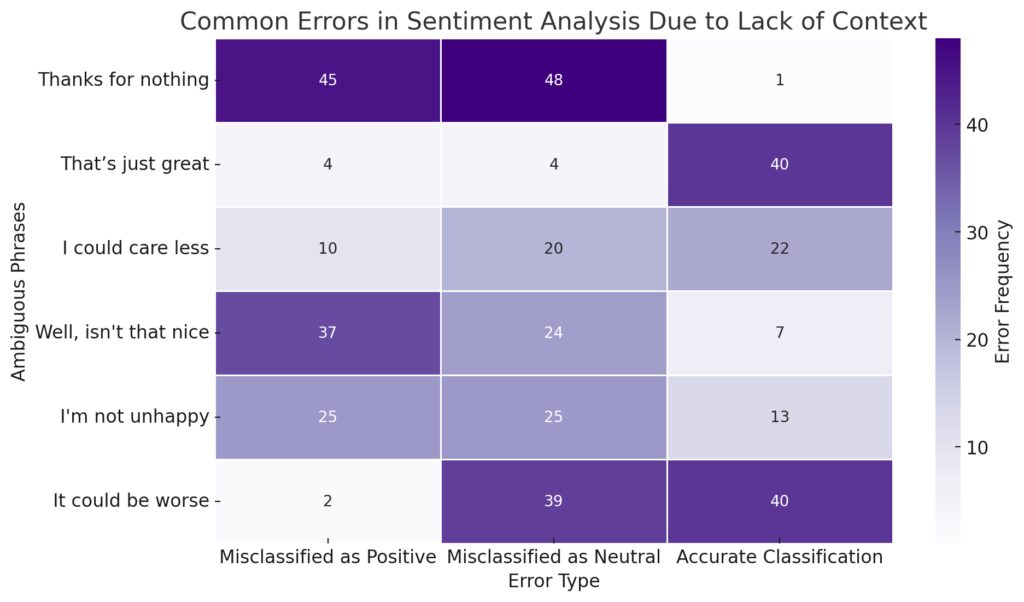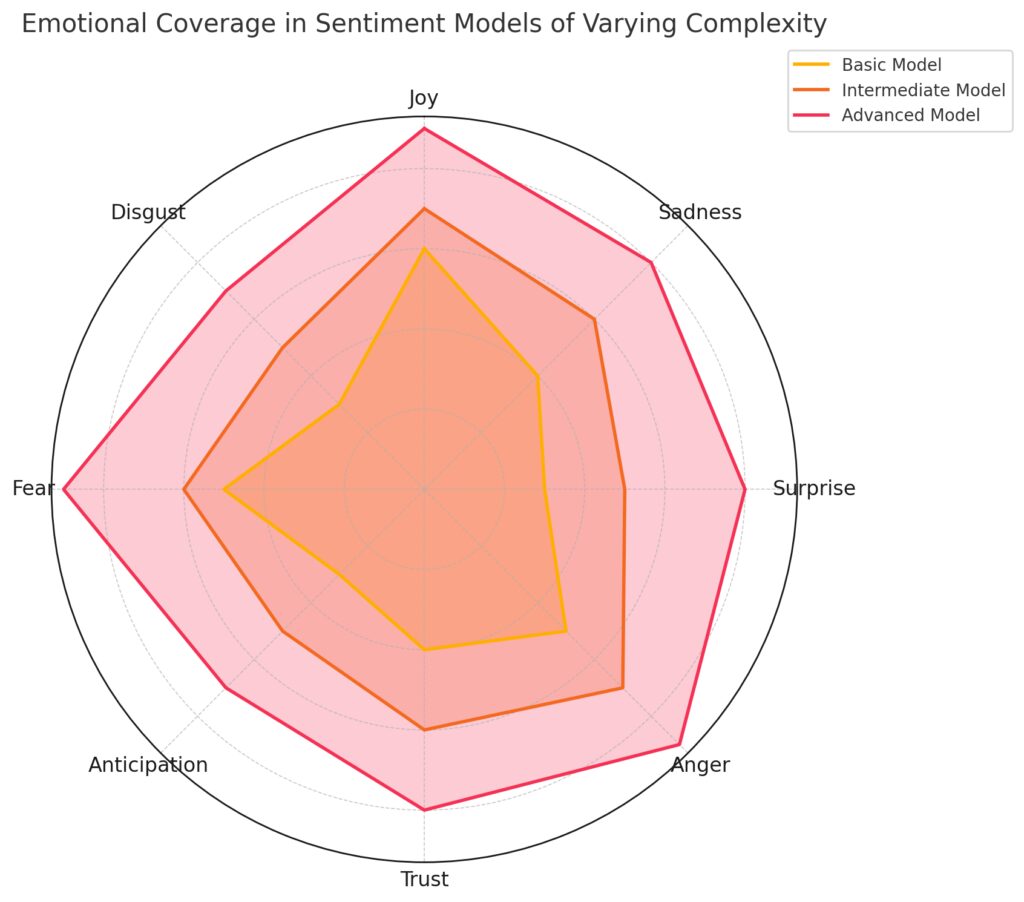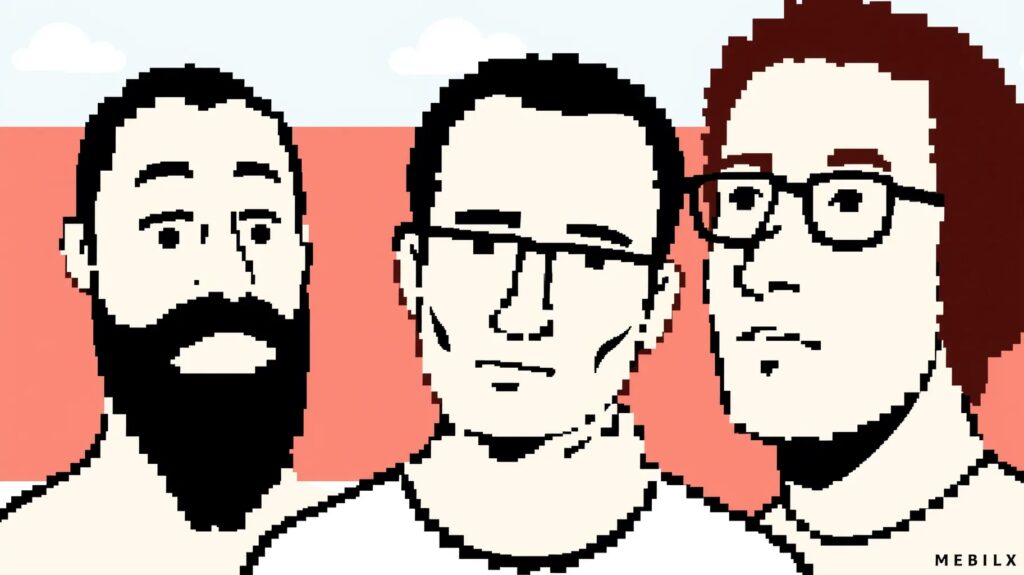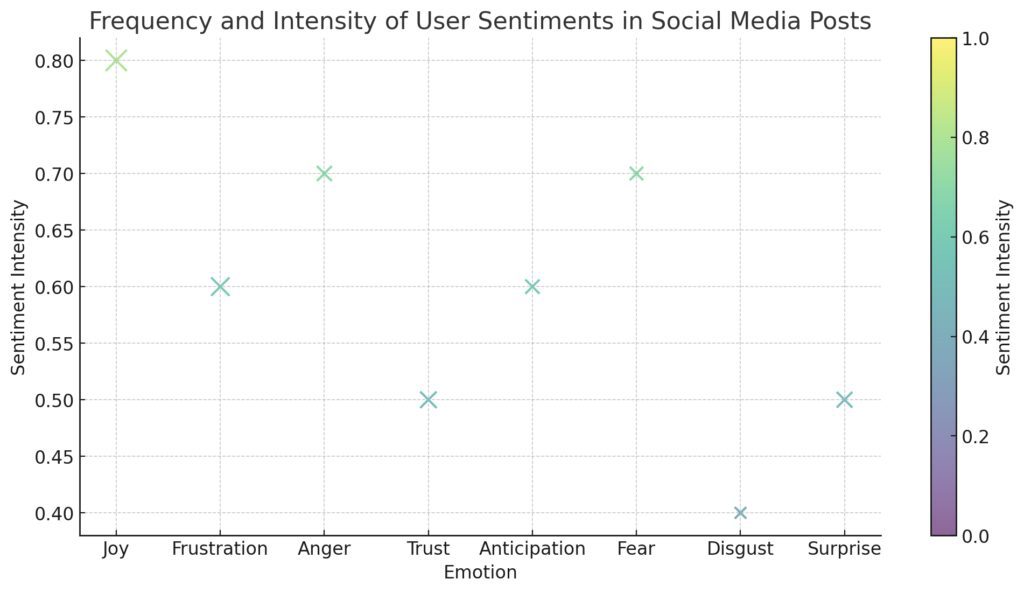
Beyond Basic Sentiment Analysis: Advanced Techniques for Emotional Intelligence in NLU
As Natural Language Understanding (NLU) evolves, so does the demand for emotionally intelligent systems capable of nuanced language interpretation.
While basic sentiment analysis captures positive, negative, or neutral tones, it misses the emotional richness required to truly understand user intent. This article explores advanced techniques for emotional intelligence in NLU, revealing how they enable a deeper connection between AI systems and human users.
Expanding Sentiment Analysis: Why Basic Techniques Fall Short
Recognizing the Limits of Traditional Sentiment Models
Sentiment analysis in its simplest form—classifying text as positive, negative, or neutral—has obvious limitations. These basic techniques can’t distinguish between emotions like excitement and anxiety, both of which could be categorized as positive in traditional models. They also struggle with irony, sarcasm, and more complex emotions. This one-size-fits-all approach might work for rudimentary insights, but for applications that demand more nuance, it falls short.
For example, a customer service chatbot needs to do more than just detect general negativity. It should recognize the frustration of a customer needing urgent support, as opposed to disappointment that can be addressed over time. This differentiation is crucial in delivering the right response.

Phrases: Ambiguous statements like “Thanks for nothing” and “I could care less.”
Error Types:Misclassified as Positive
Misclassified as Neutral
Accurate Classification
Darker colors represent higher frequencies of errors, highlighting phrases that sentiment analysis models often misinterpret due to context ambiguity. This helps in identifying specific phrases that require improved handling in sentiment analysis algorithms.
The Impact of Context on Emotion Perception
In sentiment analysis, context plays a key role. Words and phrases shift meaning depending on their surrounding text, prior interactions, and even cultural nuances. Basic sentiment models often overlook these elements, resulting in misleading conclusions. For instance, the phrase “Thanks for nothing” might be mistakenly flagged as gratitude in a basic model but actually expresses frustration. To accurately gauge emotions, advanced models incorporate contextual embeddings, adding layers of situational understanding.
Going Beyond Text: Multimodal Sentiment Analysis
Text alone is limited; real emotional intelligence considers multiple communication channels. Multimodal sentiment analysis combines text with non-verbal cues—like vocal intonation, facial expressions, or even user behavior patterns—to paint a fuller picture. When applied to platforms like video customer support or virtual meetings, it enables a deeper understanding of user emotions, allowing systems to respond with greater empathy and appropriateness.
For example, analyzing vocal pitch changes in customer calls or tracking facial expressions in video chat can improve a system’s ability to sense escalating frustration, adapting responses dynamically to improve satisfaction.
Emotion Classification Techniques: Going Beyond Positivity and Negativity

Emotion Taxonomies and Complex Classification Models
Instead of merely positive or negative, advanced models classify emotions across a rich taxonomy—happiness, sadness, anger, surprise, and more. These models typically rely on deep learning and transformer-based models, which excel in identifying nuanced emotional cues. They can distinguish between feelings of anticipation versus surprise, or fear versus anger, offering greater granularity in interpreting emotional states.
One popular framework is Plutchik’s Wheel of Emotions, which groups emotions into a spectrum. By leveraging such a taxonomy, systems achieve a more layered emotional understanding, making their responses feel tailored and responsive.

Emotions: Joy, Sadness, Surprise, Anger, Trust, Anticipation, Fear, and Disgust.
Models:Basic Model: Limited emotional range, especially in nuanced emotions.
Intermediate Model: Moderate coverage across most emotions.
Advanced Model: Extensive coverage, capturing a wider range of emotions with higher intensity.
This chart highlights how advanced models tend to achieve broader emotional coverage, essential for capturing complex sentiments accurately
Harnessing Emotion Embeddings for Enhanced Accuracy
Emotion embeddings encode emotional states as vectors, capturing subtleties missed by traditional word embeddings. These embeddings transform phrases into high-dimensional space, capturing latent emotion patterns and relationships. For instance, “I’m disappointed” and “I feel let down” may share a similar vector, enabling models to recognize related emotions without needing an exact keyword match.
This technique supports complex emotional classifications in real-time applications, like virtual therapists or empathetic chatbots. By embedding emotions into the model, these systems can identify recurring emotional patterns, personalizing user interactions in a way that feels both intuitive and authentic.
Sentiment Analysis Meets Personality Detection
Emotional intelligence extends beyond detecting momentary feelings; it includes recognizing underlying personality traits. Advanced NLU models can now combine sentiment analysis with personality detection to predict user behavior patterns, preferences, and interaction styles. This combination allows for hyper-personalized interactions.
For instance, a sales AI might adapt its style based on whether a user exhibits traits of openness or introversion. Similarly, a healthcare chatbot can modify its language and recommendations based on a user’s personality profile, improving the effectiveness of advice and fostering greater trust.
Applying Contextualized Emotion Analysis in Real-World Applications
Adaptive Learning Systems with Emotional Intelligence
Educational platforms increasingly incorporate emotionally intelligent NLU to support adaptive learning. When a student expresses frustration or confusion, the system can offer additional guidance or adjust the lesson difficulty accordingly. This emotional awareness not only keeps students engaged but also tailors learning experiences to individual emotional needs, a crucial factor in effective education.
By understanding emotional responses, these systems can track trends in motivation or disengagement, helping teachers and students alike identify problem areas faster than traditional feedback mechanisms.

Initial Inquiry: User begins interaction.
Emotion Detection: The chatbot assesses user emotions, guiding the response strategy.
Response Selection:Empathetic Response: Used when emotional cues suggest empathy is beneficial.
Escalation to Human Agent: Chosen for complex or highly emotional cases.
Automated Solution: Directs users to self-service resources when appropriate.
Resolution Outcomes:Satisfied: Positive outcome from effective response selection.
Neutral: Mixed outcome with less impact.
Unsatisfied: Negative response, often from automated resolutions lacking empathy.
This flow highlights how emotion detection impacts resolution satisfaction, showing paths where emotionally adaptive responses lead to better outcomes.
Enhancing Customer Experience with Emotional AI
In customer service, knowing a user’s emotional state in real time is invaluable. An emotionally aware AI system can adjust its tone, language, and even response time based on detected emotions. Imagine a scenario where a chatbot detects rising frustration in a user’s responses and escalates the case to a human agent proactively, ensuring the issue is resolved with care.
By tailoring responses to a customer’s emotional state, companies create a more supportive experience, which fosters customer loyalty. Major brands using emotional AI report higher customer satisfaction and fewer escalations, proving the value of advanced emotional intelligence in high-stakes interactions.
Building Empathy into Healthcare AI for Patient Support
In healthcare, emotionally aware systems assist in mental health support, where understanding subtle shifts in language can indicate mood changes. For instance, chatbots offering mental health support can flag terms indicating severe distress or suicidal ideation, triggering an alert to human professionals. The potential here is life-saving, particularly for users who may not seek out traditional help channels.
By identifying emotional trends, these systems can support personalized mental health treatment, providing emotional validation while seamlessly escalating urgent cases to human professionals when necessary.
Using Context-Aware Neural Networks for Emotion Detection
BERT and Transformer Models in Emotional NLU
Transformer models like BERT (Bidirectional Encoder Representations from Transformers) represent a leap forward for emotion detection. BERT’s bi-directional nature enables it to understand words in context by examining both left and right text sequences simultaneously. For emotion analysis, this is a game-changer; it allows models to capture nuances in user sentiment and context that were previously missed.
When BERT or similar models are fine-tuned for emotion detection, they can distinguish subtle differences, such as annoyance versus anger, without needing rigid rule-based algorithms. This flexibility has made transformer models the backbone of emotionally aware AI, especially in text-heavy applications like social media monitoring or feedback analysis.

Text Input Processing: Begins with basic text preprocessing, such as removing stop words and punctuation.
Tokenization: Splits text into tokens for analysis.
Contextual Embedding: Uses transformers (e.g., BERT) to embed text contextually.
Emotion Classification: Classifies the text based on embedded context.
Predicted Emotion Outcome: Concludes with an identified emotion, such as happiness, anger, sadness, or fear.
GPT Models for Conversational Empathy
The GPT (Generative Pre-trained Transformer) family of models is also transforming how AI handles emotional intelligence in natural language. Trained on vast datasets, GPT-based systems can generate responses that are contextually appropriate and emotionally resonant, making them well-suited for conversational AI. Through fine-tuning, these models learn to match users’ emotional tone, enabling more engaging and responsive conversations.
This capability is invaluable in applications like virtual companions or customer support agents, where the ability to respond with empathy makes AI interactions feel more human and trustworthy.
Enhancing Multilingual Emotional Understanding with Cross-Lingual Models
Emotion varies across cultures, but cross-lingual transformer models can now detect these nuances. By training on multilingual datasets, they grasp subtle cultural differences in emotional expression. This is especially valuable for global brands, allowing them to provide emotionally aware service across languages and regions.
These models benefit cross-cultural communication applications, bridging emotional understanding in diverse settings.
Practical Implementations of Emotionally Intelligent NLU Across Industries

Emotion Detection in Social Media Monitoring and Brand Reputation
In the age of social media, brands face constant scrutiny. Emotionally aware NLU can analyze social media posts, reviews, and comments to understand not just sentiment but the depth of customer emotions. Advanced NLU tools pick up on specific emotions like frustration, loyalty, or joy, enabling brands to respond meaningfully. For example, if a large segment of users express excitement over a product feature, a brand might amplify this with promotional content. Conversely, detecting rising frustration around customer service can prompt internal reviews or quick public responses.
Additionally, real-time emotion analysis in social media can help prevent PR crises. When systems detect a sudden spike in anger or disappointment, alerts can be set to respond quickly, saving brand reputation by addressing the issue promptly and empathetically.

X-axis: Shows different emotions, such as joy, frustration, and anger.
Y-axis: Represents sentiment intensity, with higher values indicating stronger emotional expression.
Bubble Size: Indicates the frequency of each sentiment in recent posts, with larger bubbles showing more commonly expressed sentiments.
Color Gradient: The color intensity corresponds to sentiment intensity, offering a visual cue on the strength of user emotions.
This visualization highlights both the prevalence and emotional strength of sentiments, helping to understand user sentiment trends
Emotionally Intelligent NLU in Human Resources and Employee Well-being
Emotionally intelligent NLU is revolutionizing employee experience within HR departments. Tools that gauge employee emotions in surveys, feedback forms, or internal communication channels provide HR with actionable insights. Rather than analyzing generic satisfaction levels, these tools capture nuances like burnout, satisfaction, or engagement. This information can help HR address issues before they escalate, creating a healthier and more supportive work environment.
For example, sentiment analysis in pulse surveys allows managers to spot early signs of disengagement or stress. By understanding employees’ emotional states, companies can adjust workload expectations, offer resources for stress relief, or provide recognition where needed. Emotionally aware insights are essential in remote work setups where gauging employee morale is harder without face-to-face interaction.
Smart Assistants with Emotional Sensitivity
Virtual assistants like Alexa, Siri, or Google Assistant have become indispensable for millions. While their primary role is task-oriented, advanced NLU enables them to detect emotional cues in user interactions. For instance, if a user sounds frustrated while asking for help, an emotionally aware assistant can adjust its tone, provide clearer instructions, or ask follow-up questions to ensure satisfaction.
Such systems rely on voice sentiment analysis and contextual understanding, allowing assistants to respond with empathy. A user dealing with a stressful day might hear a calm, reassuring tone from their assistant, adding a subtle but meaningful layer of support. These emotionally aware responses enhance user experience, as people feel more comfortable and understood in their interactions.
Financial Services with Emotionally Aware Customer Support
Customer support in financial services often handles sensitive situations involving personal finance. Emotionally aware NLU enables chatbots and virtual assistants in banking to respond with sensitivity, particularly when clients discuss delicate matters like debt, financial hardship, or disputes. Detecting emotional cues helps these systems route highly emotional cases to human representatives trained for empathy or provide soothing, reassuring language when offering automated assistance.
For example, an emotionally intelligent banking chatbot might recognize frustration from a client concerned about transaction delays. By prioritizing emotionally charged messages, the system can route those to human agents more quickly or escalate them to a supervisor. This approach helps banks build trust and deliver compassionate support, which is especially important in high-stakes, emotionally charged environments like finance.
Integrating Emotional Intelligence in AI for Enhanced Customer Experience
Personalization and Dynamic Content Recommendations
Emotionally aware NLU allows content providers to tailor recommendations based on users’ emotional states. Platforms like streaming services and news aggregators can personalize content suggestions by analyzing users’ recent interactions and detected emotions. If a user often engages with upbeat, humorous content, the system might prioritize similar recommendations to boost engagement.
Dynamic recommendations extend beyond entertainment to healthcare and wellness platforms. If a user expresses stress or anxiety in their search terms or chat interactions, a wellness app could prioritize meditation videos or relaxation exercises in its recommendations. Emotional intelligence adds a layer of empathy to content personalization, offering users experiences that genuinely resonate.
Dynamic Ad Targeting with Emotional Intelligence
Emotionally intelligent NLU has reshaped digital advertising. Advertisers can use advanced emotional analysis to deliver ads that align with users’ emotional contexts. For example, if users engage with content that expresses happiness or excitement, ads can highlight celebratory or lifestyle-focused products. Conversely, users showing signs of stress or frustration might receive ads promoting relaxation, wellness, or financial security.
This level of emotion-based targeting not only improves ad relevance but also enhances user experience by showing ads that resonate emotionally. Advertisers who tailor messages to users’ emotional states report increased engagement, as the ads feel more personalized and meaningful.
Ethical Considerations and Challenges in Emotionally Intelligent NLU
Privacy Concerns and Data Sensitivity
Emotionally aware AI involves collecting and analyzing sensitive data, raising significant privacy concerns. As these systems gain the capability to detect nuanced emotional cues, they collect potentially revealing information about users’ mental states, preferences, and behaviors. Companies implementing these technologies need to prioritize data privacy and user consent, transparently informing users about how their emotional data will be used.
For example, companies might adopt data minimization practices to limit the information gathered and stored, using only what is necessary to improve interactions. Additionally, anonymizing emotional data can protect user identities, reducing potential misuse.

Cultural Biases: Covers fairness across demographics, potential cultural misinterpretation, and label bias.
Data Security: Encompasses data encryption, breach risks, and secure storage.
This diagram shows how these areas intersect, highlighting the unique and overlapping challenges faced in ethical NLU development for emotion detection.
Addressing Bias in Emotional Detection
Emotional intelligence in AI models can suffer from biases inherent in training data, affecting how accurately these systems interpret emotions across different demographics. For instance, certain cultures express emotions differently, leading to potential misinterpretations if a model is not trained on diverse datasets. Similarly, gender and age differences in emotional expression can skew results if not accounted for.
To improve fairness and accuracy, developers should train models on diverse data sets that capture various cultures, languages, and emotional expressions. By reducing biases, emotionally intelligent AI can serve users across demographics more equitably, ensuring accurate and fair interpretations of emotions.
Balancing Empathy with Authenticity
One challenge of emotionally intelligent NLU is finding the right balance between empathy and authenticity. Users may find it unsettling if an AI appears overly empathetic or even invasive in its emotional awareness. Building emotionally intelligent systems that feel natural and non-intrusive requires careful calibration to avoid an “uncanny valley” effect where AI responses feel artificial or excessive.
For instance, chatbots might show empathy subtly, acknowledging user frustrations without overdoing it. This balance creates a comfortable, supportive experience without crossing into uncomfortable territory, ensuring that users feel respected rather than monitored.
The Future of Emotional Intelligence in NLU: Toward Human-Like Interaction
As emotionally intelligent NLU technologies continue to develop, we can expect increasingly human-like interactions across digital platforms. Innovations in deep learning, multimodal analysis, and cross-cultural emotional intelligence are setting the stage for systems that deeply understand, interpret, and respond to human emotions. By bridging the gap between machine learning and genuine empathy, emotionally intelligent AI could soon become an invaluable tool across sectors, from healthcare to customer service.

Early 2000s: Basic sentiment analysis begins.
2010s: Rise of machine learning and deep learning for emotion detection.
Late 2010s: Introduction of transformer models like BERT and GPT, enhancing emotion detection capabilities.
2020s: Application of real-time emotion detection, with projections for multilingual emotion analysis.
2030s: Future developments in real-time emotion monitoring and integration with virtual assistants.
With responsible implementation, these advanced NLU techniques have the potential to revolutionize how humans and machines connect, creating digital experiences that feel truly personal and responsive.
FAQs
How does emotional intelligence benefit customer service?
In customer service, emotionally intelligent AI can greatly improve the customer experience by recognizing emotions like anger, confusion, or satisfaction. For example, if a chatbot detects frustration in a user’s language, it can escalate the interaction to a human agent or respond with more patience and empathy. This helps reduce customer churn, enhances satisfaction, and ensures that users feel heard and understood.
What’s the difference between basic sentiment analysis and advanced emotional NLU?
Basic sentiment analysis typically classifies text into broad categories like positive, negative, or neutral. In contrast, advanced emotional NLU analyzes a wider range of emotions and context, identifying specific feelings such as happiness, sadness, surprise, or anxiety. Advanced NLU also uses deep learning and contextual embeddings to understand meaning more accurately, improving responsiveness in applications like chatbots or customer support systems.
How is emotion detection applied in industries outside customer service?
Emotion detection in NLU has broad applications across industries. In education, it helps tailor learning experiences based on student engagement and frustration levels. In healthcare, emotionally aware systems support mental health monitoring by tracking subtle mood shifts. In marketing, it personalizes ads and content based on user emotions, increasing engagement and relevance. By understanding emotions, these systems enhance user interaction across various fields.
Are there ethical concerns with emotionally intelligent NLU?
Yes, there are significant ethical concerns, especially around privacy and data sensitivity. Emotionally intelligent systems collect and analyze sensitive emotional data, raising issues about user consent and data security. Moreover, biases in emotional detection algorithms can lead to inaccurate interpretations across demographics. To address these concerns, companies must prioritize transparency, data minimization, and ethical guidelines to protect user rights.
What role does context play in advanced emotion analysis?
Context is essential for accurately interpreting emotions in NLU. Simple phrases can change meaning based on tone, previous interactions, and cultural nuances. For instance, “That’s just great” might be positive or sarcastic depending on the context. Advanced models use contextual embeddings to analyze these subtleties, providing a more accurate understanding of emotional intent and enabling systems to respond appropriately.
Can emotionally intelligent AI detect emotions across different languages and cultures?
Yes, cross-lingual and culturally diverse training models help AI detect emotions across languages and cultures. Emotionally intelligent NLU must account for cultural differences in emotional expression; for example, expressions of frustration may differ by culture. By training on diverse datasets, these models improve their ability to interpret emotions accurately, making them more inclusive and effective for global applications.
What is multimodal sentiment analysis?
Multimodal sentiment analysis combines multiple data sources—such as text, voice, and facial expressions—to interpret emotions more accurately. By analyzing non-verbal cues like tone of voice or facial expressions along with text, it builds a fuller emotional picture. This approach is especially useful in applications like virtual meetings, telehealth, and customer support, where understanding emotions holistically can enhance communication and responsiveness.
How does personality detection enhance emotionally intelligent NLU?
Personality detection identifies underlying traits—such as openness, extroversion, or neuroticism—that influence how people communicate. By combining emotion detection with personality insights, emotionally intelligent NLU can tailor interactions more effectively. For example, in customer service, knowing that a user is typically reserved can guide a chatbot to use a more straightforward, factual tone. This deeper understanding enables AI systems to create more personalized and relevant experiences, making users feel better understood.
What are emotion embeddings, and why are they important?
Emotion embeddings are vectors that represent specific emotions in a high-dimensional space, allowing systems to capture subtle patterns and relationships among emotions. Unlike traditional word embeddings, which focus on word meaning, emotion embeddings focus on emotional nuances in language. For example, “I’m upset” and “I’m a little disappointed” might be close in an emotion-embedding space, helping systems detect related emotions even when wording differs. This technique improves accuracy in emotion detection, supporting more responsive applications in healthcare, mental health support, and customer service.
How do transformers like BERT and GPT improve emotional intelligence in NLU?
Transformers like BERT and GPT revolutionize emotional intelligence in NLU by processing text in a contextually aware, bidirectional manner. BERT, for example, considers the entire context of words in both directions, allowing it to understand complex emotions within nuanced statements. GPT models, on the other hand, can generate empathetic responses that align with a user’s emotional tone, enhancing conversational AI’s responsiveness. These transformer models enable a deeper, more accurate understanding of emotions, making interactions with virtual assistants and chatbots feel more human.
Can emotionally intelligent NLU detect sarcasm and irony?
Yes, advanced emotionally intelligent NLU models can often detect sarcasm and irony, although it remains a challenging task. Sarcasm detection requires a deep understanding of both context and tone, as sarcastic statements can convey the opposite of their literal meaning. Emotionally aware systems trained on large datasets that include sarcastic phrases can learn to recognize patterns in syntax, punctuation, and word choice associated with sarcasm. This ability is especially useful in customer service, where understanding sarcasm can prevent misinterpretation and lead to more appropriate responses.
How is emotional NLU transforming mental health support?
Emotionally intelligent NLU is making significant strides in mental health support by recognizing subtle emotional shifts in language over time. Chatbots and virtual therapy assistants can detect indicators of mood changes, like increased anxiety or sadness, and respond with supportive or therapeutic language. Additionally, emotionally aware systems can alert human professionals when severe distress is detected, making them valuable tools in providing real-time mental health support. This capability is particularly beneficial for individuals who prefer digital assistance or who might not seek help through traditional channels.
How do multimodal systems in NLU work with emotion detection?
Multimodal systems analyze and integrate data from various sources—such as text, voice tone, facial expressions, and even body language—to form a comprehensive understanding of user emotions. By combining these inputs, these systems capture nuances that text alone cannot convey. For instance, analyzing vocal pitch and tempo in addition to text can reveal stress or excitement levels. This holistic approach is especially beneficial in applications like virtual meetings, telehealth, and customer support, where non-verbal cues play a major role in interpreting emotions accurately.
Can emotionally intelligent AI be used for proactive support?
Yes, emotionally intelligent AI can be used for proactive support, especially in customer service and healthcare. By analyzing user emotions in real time, these systems can proactively reach out to assist when they detect distress or frustration. For example, a customer service chatbot might initiate a conversation with an empathetic tone if it detects that a user is repeatedly navigating troubleshooting pages. Similarly, a mental health app might send encouraging messages to users who seem discouraged or stressed, helping them feel supported without having to request help.
How do companies address the potential bias in emotionally intelligent NLU models?
To address bias, companies are training emotionally intelligent NLU models on diverse datasets that include a wide range of cultures, languages, and emotional expressions. This diversity helps reduce inaccuracies in emotional interpretation across demographics. Regular audits and bias testing also allow companies to refine models continually. By taking these steps, developers aim to make emotional NLU as fair and inclusive as possible, ensuring accurate and equitable emotional understanding across different user groups.
What role does emotionally intelligent NLU play in personalized learning?
Emotionally aware NLU enhances personalized learning by adapting to students’ emotional states. For example, if a student shows signs of frustration or confusion, the system can adjust the difficulty level of the content or provide additional resources to assist. Emotionally intelligent learning platforms can also help educators by tracking emotional patterns, making it easier to address issues like disengagement or anxiety early on. This tailored approach creates a more supportive learning environment, improving student outcomes and engagement.
Resources
Academic Papers
- “BERT: Pre-training of Deep Bidirectional Transformers for Language Understanding”
This seminal paper by Jacob Devlin and colleagues introduced BERT, a model that has been foundational in advancing NLU, including applications in emotion and sentiment detection. Available on arXiv. - “Context-Aware Sentiment Analysis: A Multimodal Perspective”
This paper explores multimodal sentiment analysis, which combines text, audio, and visual cues to interpret emotions more accurately. The techniques discussed here are central to creating fully context-aware emotional intelligence systems. - “Emotion Detection from Text: A Survey” by Javier Montes-Alvarez, Asunción Gómez-Pérez, and Ricardo Colomo-Palacios
A comprehensive survey covering different methods, from rule-based to deep learning approaches, used in emotion detection. This paper is available through IEEE Xplore or university libraries.
Tools and Libraries
- Hugging Face Transformers
A widely used library for implementing advanced NLP models such as BERT, GPT, and RoBERTa. Hugging Face provides pre-trained models that can be fine-tuned for emotional NLU tasks. Visit Hugging Face. - NLTK and SpaCy
These Python libraries are foundational for NLP, offering tools for text processing, tokenization, and sentiment analysis. SpaCy in particular provides an easy way to build custom NLU models for emotion detection. - IBM Watson Tone Analyzer
An AI-powered tool for analyzing emotional tone in text. It can be integrated into applications for real-time emotion detection, making it useful for chatbots and customer service tools.